Newark Waste and Water Improvement Project (2020)
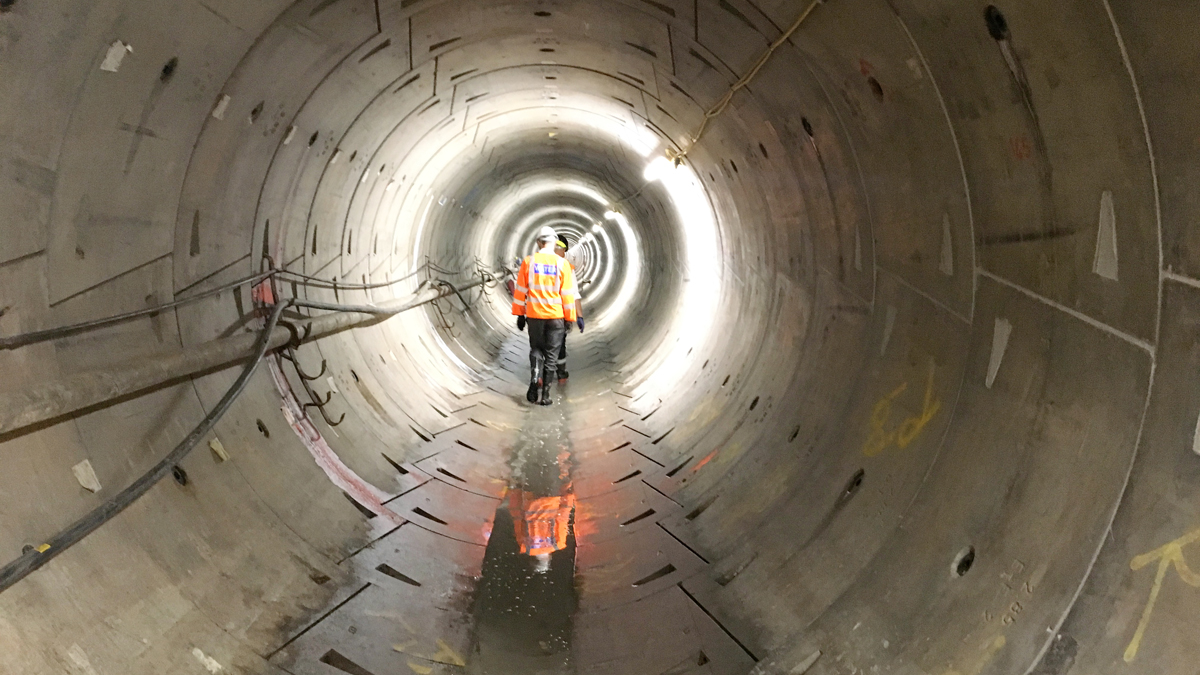
The 2.8km, 2.85m diameter tunnel constructed beneath the streets of Newark - Courtesy of Severn Trent
Severn Trent have made a £60m investment in Newark-on-Trent upgrading the sewers and water supply network throughout the town. The project provided relief to some 400 homes and businesses from sewer flooding, and provided a robust water supply system which will serve the town for many years to come. The project included a 2.8km segmental tunnel passing beneath the town, 2km of pipe jack tunnels, 2.6km of water mains renewal, 6.6km of open cut sewers, and more than 11km of new water mains.
Background: Waste
In 2012 Severn Trent promoted a project to explore the feasibility of alleviating flood risk affecting 68 properties in the town of Newark-on-Trent in Nottinghamshire. The project team quickly became aware that the flood risk predicted by the sewerage catchment hydraulic model and customer reporting did not align. Customer surveys were undertaken at locations where flooding was predicted, with catchment and flow surveys carried out to improve confidence in the performance of the hydraulic model. The result of this work identified approximately 400 properties at risk of either internal or external sewer flooding.
A combination of population growth, infill development, and increased flows to the existing combined sewerage system from ‘urban creep’ of impermeable areas, had led to the sewer system lacking the capacity needed to cope in times of heavy rainfall.
It became clear to the team that the flood risk could not be managed with local solutions and it would be necessary to undertake a major upgrade of the sewer network to alleviate the risk of sewer flooding across the town. Work on such a scale would present an opportunity to resolve a number of unsatisfactory combined sewer overflows (CSOs) throughout the town, to rehabilitate sewers in poor structural condition, and to upgrade and renew the inlet pumping station at Crankley Point Sewage Treatment Works (STW).
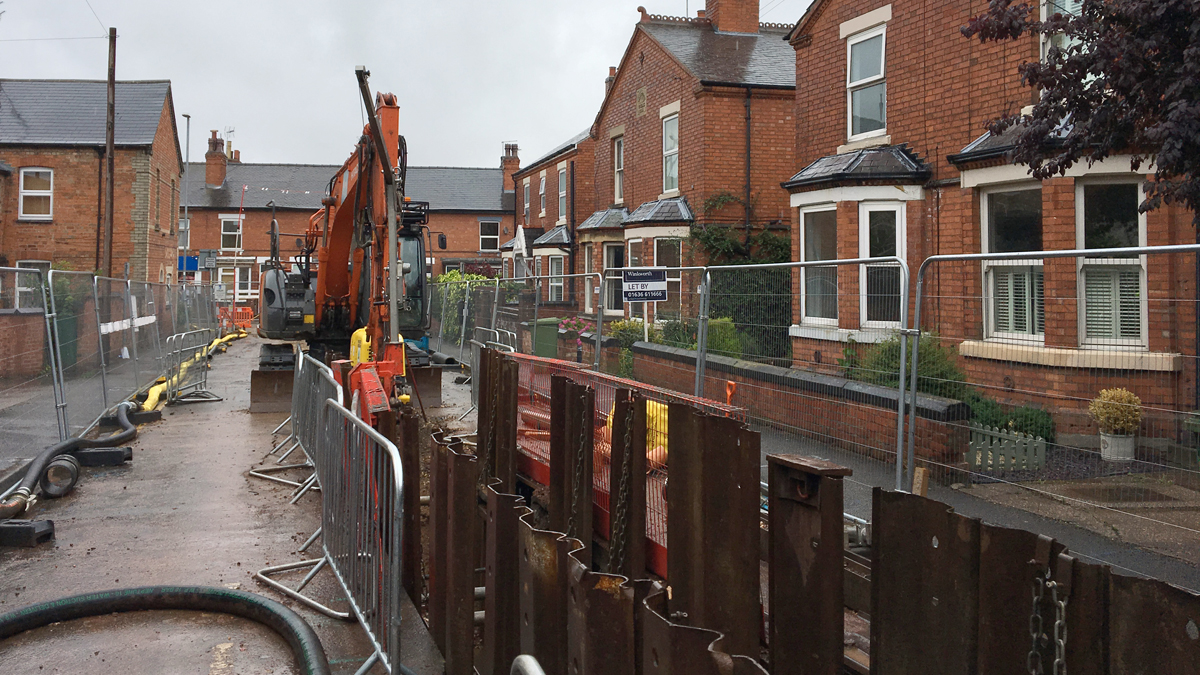
Extensive sewer upsizing was carried out, to increase capacity and prevent flooding in storm conditions – Courtesy of Severn Trent
Background: Water supply
Newark had been identified as a ‘growth point’, with significant housing and commercial development planned. Studies showed that within 25 years, Severn Trent faced a 46% increase in demand for water from an existing network which was nearing full capacity. New infrastructure was required to supply the development areas, and ultimately bring more water into the town.
Modelling of the Newark Control Group identified that the scale of development proposed would have a detrimental effect on pressures within the area, with the existing network capacity only able to support a maximum of 750 additional properties. With construction of the first housing development scheduled to commence in April 2015, Severn Trent implemented a project to provide a new connection to this development from the existing water supply network.
In order to deliver water to the new development areas to the east and south of the town, a new outlet main from Beacon Heights Reservoir would be needed. As future demand from the new developments increased, a new trunk main to supply water from Nottingham to Newark would also be required.
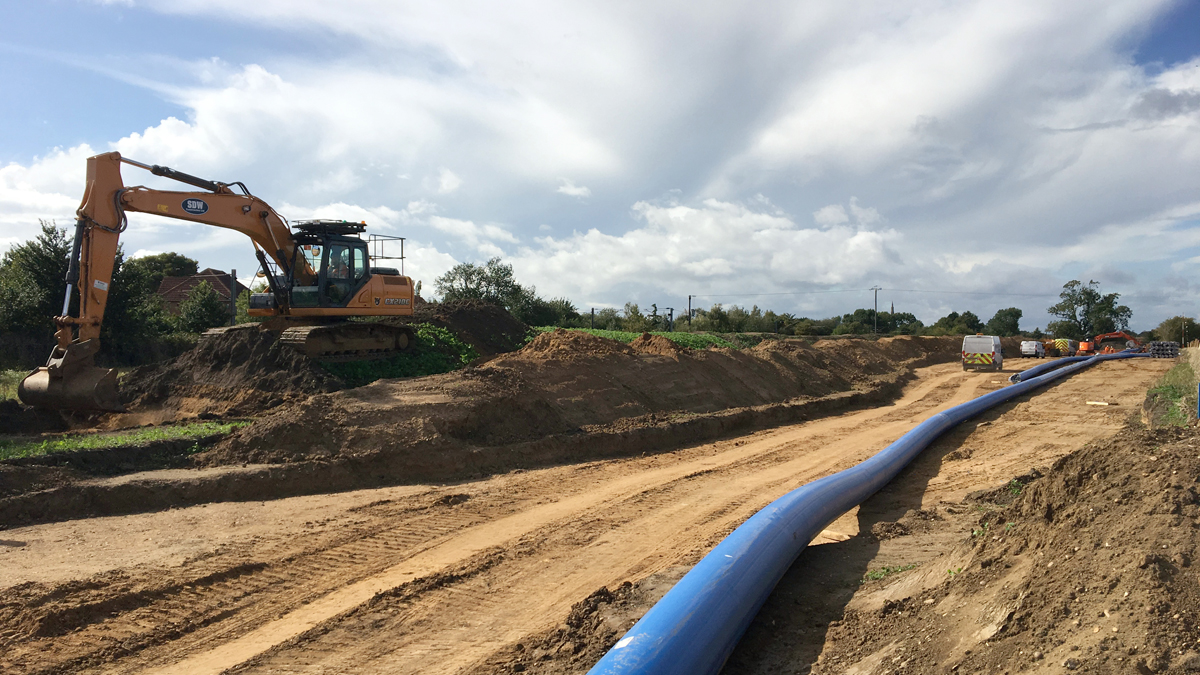
New water supply pipeline being installed to support new development around the town – Courtesy of Severn Trent
A study of the Newark Water Control Group was carried out during September 2015 to analyse risks on the network and update analysis on the Newark Growth Study. This identified resilience concerns which would be compounded by future supply demand due to growth of the town.
Results of the study found over 2km of existing mains were reaching the end of their serviceable life, and that improvements to network design, increasing connectivity and operability would improve the ability to rezone, respond quickly to incidents and operate an efficient network.
Solution: Waste
The Newark sewer network is primarily a combined system, and although early feasibility work looked at potential for surface water separation, there were few opportunities available without work required at individual property level. Not only was this cost prohibitive, but hydraulic modelling demonstrated that even with separation, to solve the flooding problem would require the upsizing of the town’s arterial sewers to enable increased flows to be transferred to the existing Crankley Point STW. The treatment works, located to the north of the town, is bounded to the west by the River Trent, to the south by the East Coast Main Railway Line, with the Nottingham to Lincoln Railway Line and A46 to the east. To the north is an area of open land and the A1. These geographical constraints would require any new sewer into the works to be constructed by some form of tunnelling technique.
Various routes and lengths of tunnel were considered, with the preferred solution being a new 3km tunnel from the southern end of Mill Gate to the Crankley Point STW. Initial plans for a pipe jack tunnel were revised to a segmental tunnel following consultation with stakeholders in the town and detailed reviews of cost impact and risk associated with delivery of each option. The proposed tunnel alignment generally followed the route of the public highway, avoiding passing beneath residential and commercial properties. The depth of the tunnel was determined by the need to minimise any settlement of the two rail crossings. The more critical crossing being that of the East Coast Main Railway Line, where the tunnel was to be driven 11m deep from existing ground level to crown of the tunnel, within the Mercian Mudstone. This would result in the tunnel being 15m deep beneath the Nottingham to Lincoln Railway Line, and the existing ground level at Crankley Point.
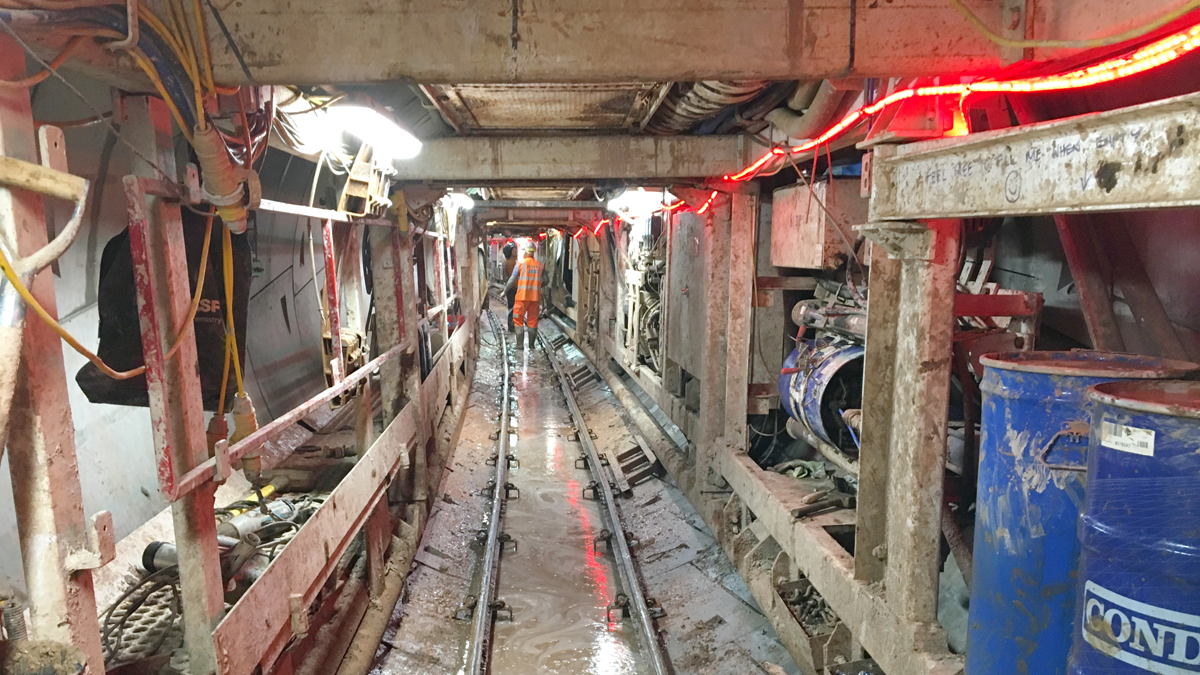
Multiple gantries follow behind the cutting head carrying ancillary equipment to support the TBM – Courtesy of Severn Trent
Abandonment of ten Combined Sewer Overflows throughout the town was to be achieved through transfer of future peak flows via the tunnel to a new terminal pumping station (TPS) at Crankley Point STW. Two separate pump arrangements would lift flows to the existing treatment works and in cases of extreme storm event to a new screening chamber, prior to outfall to the River Trent. The pumping station is the subject of a previous article published in UK Water Projects 2019.
A further 1km long, tunnel of 1.2m diameter was proposed to be constructed by pipe-jack techniques, from a point of connection with the main tunnel at the Queens Road, North Gate road junction, running east along Queens Road and Sleaford road before turning south to terminate at the junction of Barmby Gate and Vernon Street.
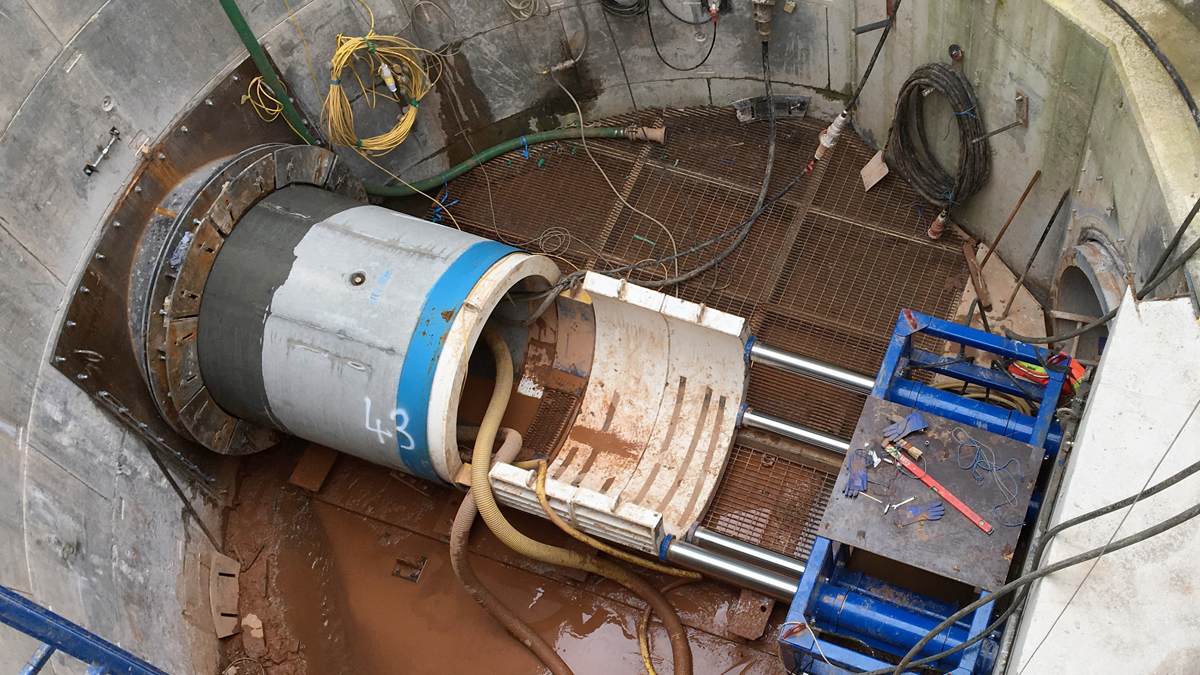
Hydraulic rams pushing pipes behind slurry system TBM as part of pipe-jack tunnel – Courtesy of Severn Trent
In addition to the new tunnels, some 7km of new sewers were to be constructed by open cut across the town to collect and convey flows from various streets to the new tunnels. The pipelines generally comprised of online and offline sewer replacement within the extents of the public highway. New pipes with diameters ranging between 225mm and 1500mm were proposed in some 37 streets in a residential urban environment.
Over 2km of sewers were identified from CCTV records as being in a poor structural condition and requiring rehabilitation through relining. In addition another 2.5km of sewers were considered of a critical importance to the operation of the sewer flooding strategy, requiring cleansing and further inspection to confirm if any rehabilitation work was necessary.
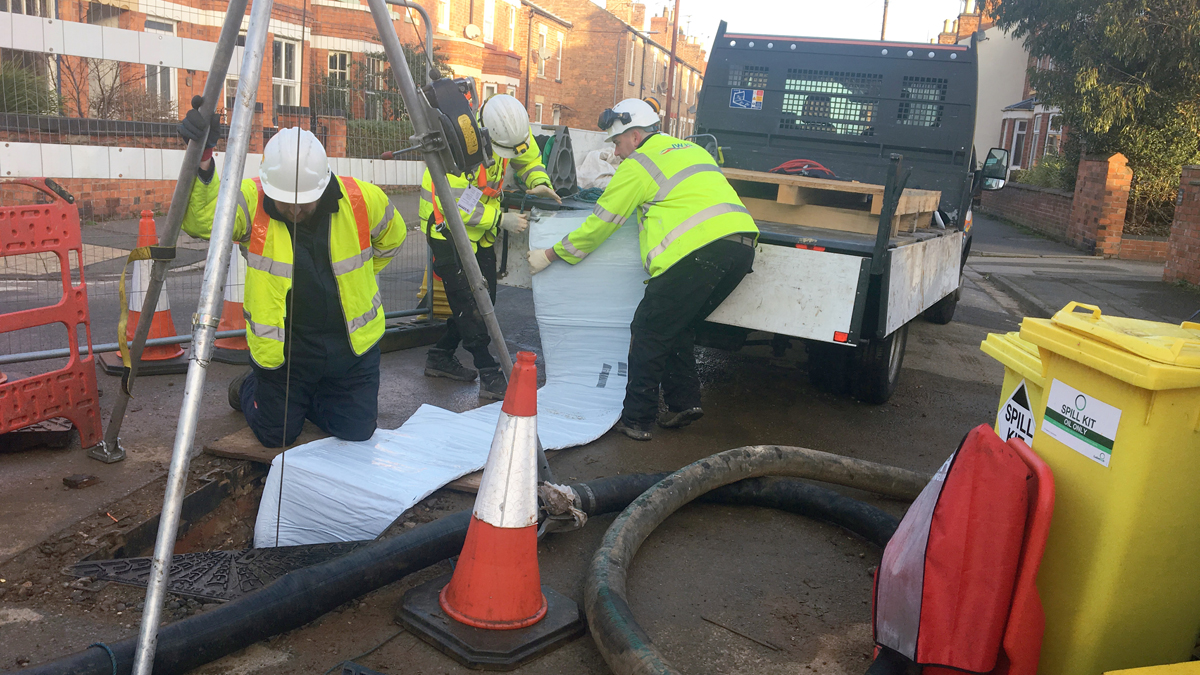
Liner being inserted into sewer, winched from next manhole, prior to inflation and curing – Courtesy of Severn Trent
The feasibility work included an outline analysis of highway drainage inlet capacity in the areas adjacent to the works. This identified some locations where there was an insufficient number of surface water gullies, resulting in potential highway and overland flooding problems. The Severn Trent team engaged with Nottinghamshire County Council who provided partnership funding to install additional gullies. These were included in the project scope to deliver a holistic solution to flooding problems with all works carried out at the same time.
A key driver in the solution development was to minimise disruption to residents, commuters and visitors to the town. The decision to use a segmental tunnel rather than a pipe-jacked tunnel reduced the number of construction shafts from 12 along the line of the tunnel to just two, one at each end.
Whilst the main tunnel could be constructed without impact at surface, the existing sewer system had to be connected to the new tunnel at key locations in the town. Rather than constructing a traditional shaft, 1200mm diameter drop pipes were proposed, drilled from surface, connecting an overflow chamber built on the existing sewer to the new tunnel below. The segmental tunnel and drop shafts, avoided significant construction and traffic impacts, reducing an 18-month period with road closures throughout the town, to a 17-week period with a one-way system in operation.
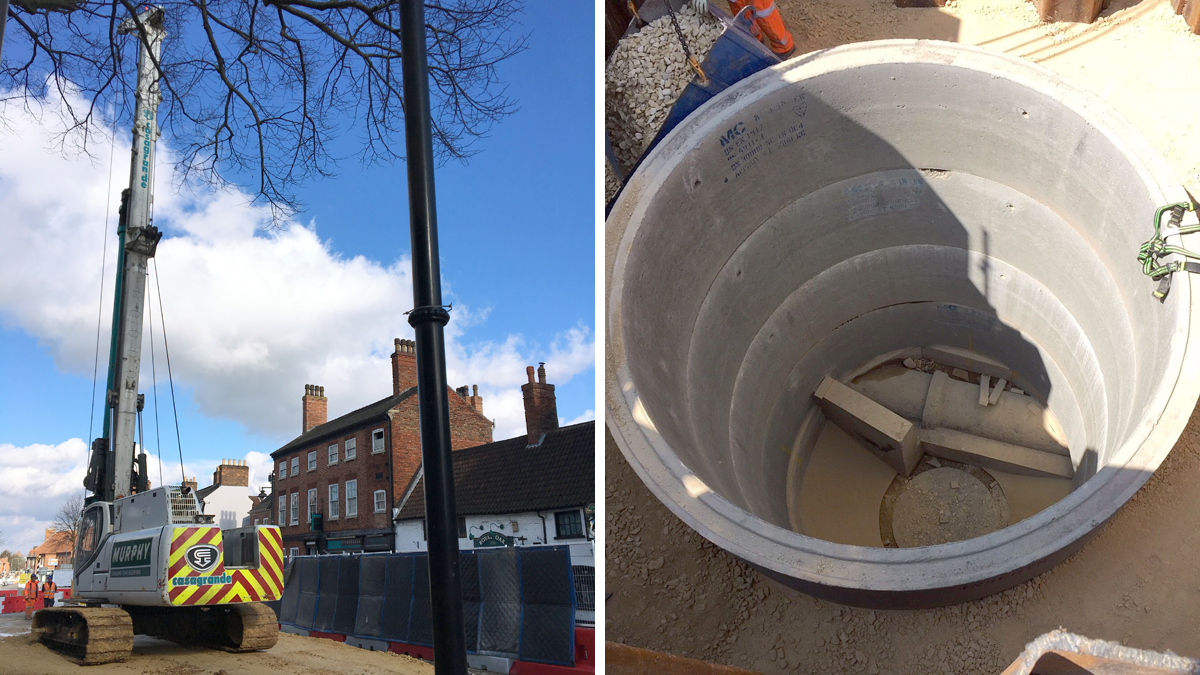
(left) Drilling rig set up ready to drill drop shaft outside Newark Castle and (right) overflow chamber and drop pipe on Castle Gate Newark – Courtesy of Severn Trent
Where opportunity allowed, the existing sewers were to be retained with rider sewers laid at a higher level connecting from manhole to manhole. In normal dry weather conditions the flows would be contained within the existing sewer, however in storm conditions, as the sewer surcharges, the flow would rise in the manhole and spill into the rider sewer. As the depth of the rider sewer is less than the depth of the existing sewer, and no property connections need to be made to the new pipe, programme savings can be achieved reducing the construction duration and hence the impact to residents and road users alike.
Solution: Water supply
A route was established for two pipelines to be installed from Beacon Heights Reservoir through fields around the outskirts of the town to the east, terminating to the south of the village of Balderton. In the short term these two pipes would provide a new water supply to serve the planned development areas. As demand increases in the future, however, one of the pipes will be connected to the proposed new supply pipeline from the north of Nottingham to deliver more water into Newark’s Beacon Heights Reservoir. By installing the two pipes together disruption to customers and landowners would be reduced, together with savings achieved on additional future excavation and reinstatement costs. The route would require the two pipes to pass beneath the East Coast Main Railway line, and under the A1 at two different locations.
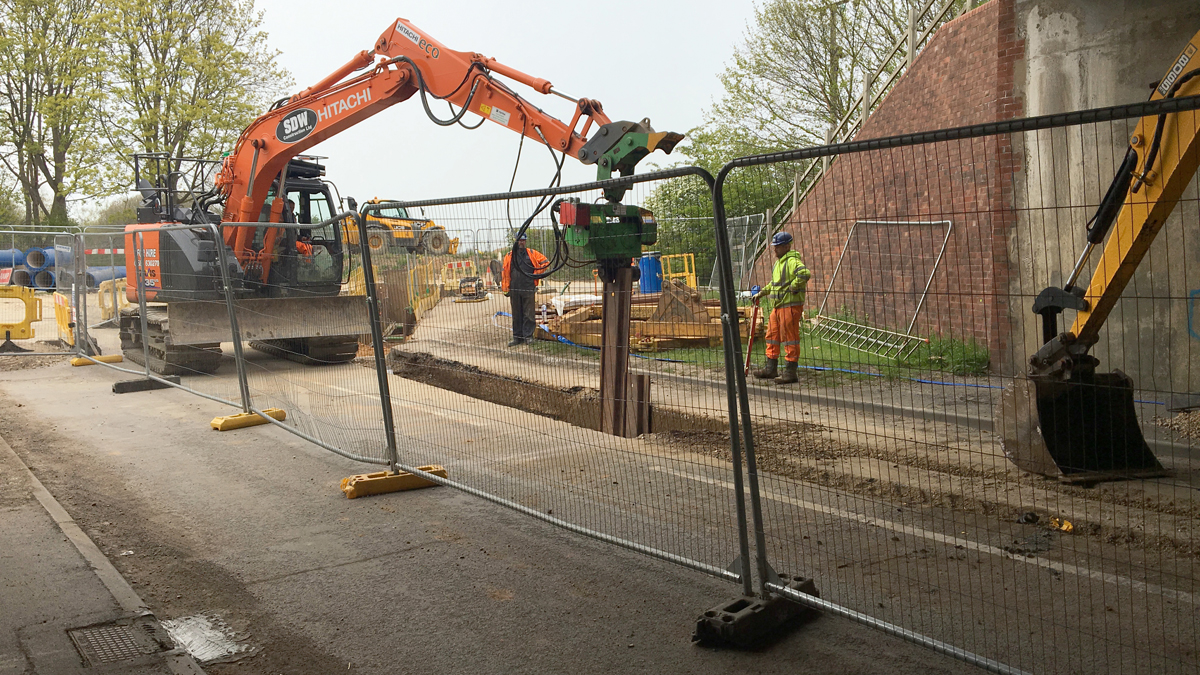
Excavation for new water mains through underpass beneath A1 – Courtesy of Severn Trent
In order to provide increased resilience and control, 5 (No.) new trunk main flow meters and 32 (No.) new sluice valves were proposed to be installed across the network. The flow meters would provide improved intelligence on the operation of the network, whilst the valves would enable impacts to customers to be minimised during maintenance or in the event of a burst.
Some areas of Newark received their water directly from either one of two strategic water mains which supplied the town. Review of the network had identified the risk that these areas could be left with no water supply if one of the mains needed to be taken out of service. A cross connection between the two mains at a specific location was included in the project scope, to alleviate this problem.
A schedule was developed of existing life expired water mains, which were to be renewed, in order to reduce the risk of them failing in the future. Four new pressure management systems were also to be provided, to prevent build-up of pressures in the network and reduce the risk of leakage and potential burst pipes.
Procurement
Delivery of a combined water and waste programme of work as one package, with a single supply chain partner, provided a great opportunity to maximise efficiencies and to reduce customer disruption. The tunnelling and deep large diameter sewers formed a significant proportion of the estimated project cost. As Severn Trent owned only limited historic cost data for these items, it was decided to procure the works through a mini-tender of all the Tier 1 Framework Contractors rather than a direct allocation to any one supplier.
Following the tender process, the BNM Alliance, comprising a joint venture between nmcn plc (now Galliford Try) and Barhale Limited, was appointed under a design and build contract based on Severn Trent’s framework terms, a modified version of the NEC 3 Option C Target Cost Contract.
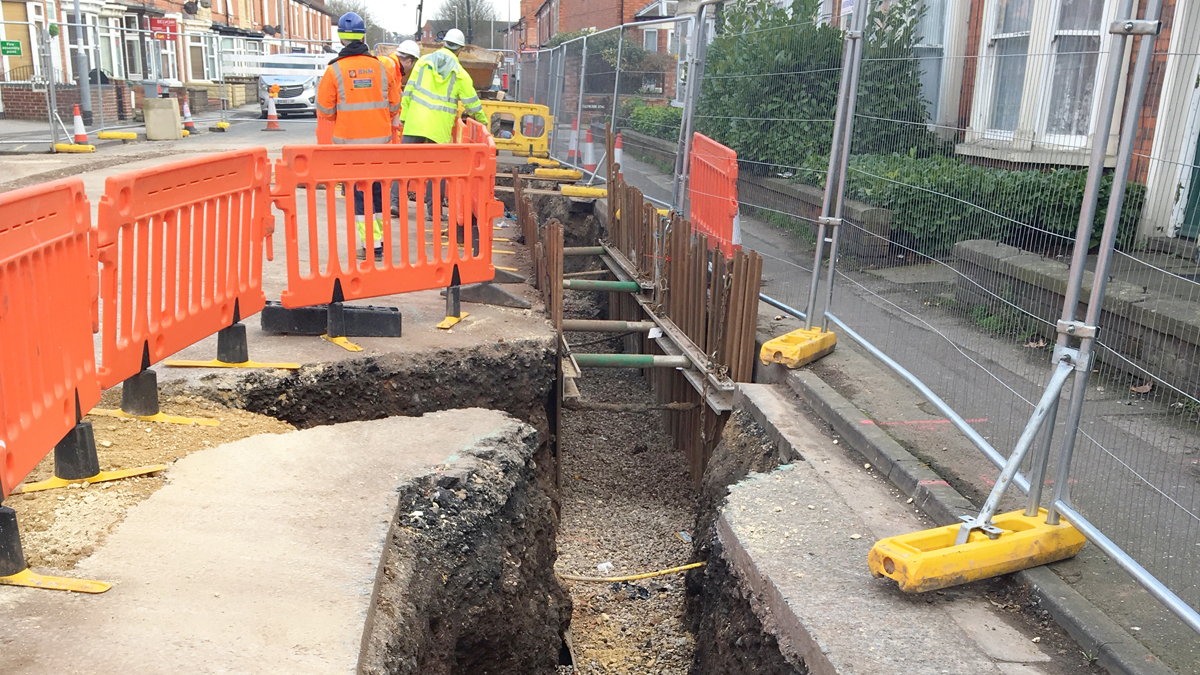
Having both waste and water works under one contract simplified arrangements for water main diversions required for waste works – Courtesy of Severn Trent
Newark Waste and Water Improvement Project: Supply chain – key participants
- Principal contractor: BNM Alliance – Barhale/nmcn PLC (now Galliford Try) joint venture.
- Designer: Water and waste south open cut: Pick Everard
- Designer: Waste north and east open cut, shafts and tunnels: GHD Ltd
- Geotechnical investigation: Geotechnics Ltd
- Water sub-contractor: Heartland Pipelines Ltd
- Waste open cut sub-contractor: M2 Civils Ltd
- Secant piling & drop shaft drilling: J Murphy & Sons Ltd
- Aarsleff sheet piling: Aarsleff Ground Engineering
- Traffic management: Traffix Ltd
- Road surfacing: RPH Robinsons Paver Hire Ltd
- Track monitoring: Bridgeway Consulting
- Sewer rehabilitation: IWJS Ltd
- CCTV: CPS drainage solutions
- Tunnel boring machine: Lovat
- Tunnel boring machine: Iseki Unclemole
- Tunnel ring segments: FP McCann
- Aggregates: Laffey’s Ltd
- Aggregates: Breedon Group plc
- Concrete shaft segments: FP McCann
- Pipes: Polypipe
- Pipes: Marshalls CPM
- Concrete: Breedon Group plc
- Concrete: Tarmac
- Dropshaft pipework: Franklyn Yates Engineering Ltd
- Safety showers & eyebaths: Aqua Safety Showers International Ltd
Waste: Design and construction
The horizontal and vertical alignment of the tunnelled, no-dig and open cut sewer routes were defined as part of the hydraulic design for which Severn Trent retained responsibility. Whilst approximate locations of all shafts, manholes and connections were identified on the tender drawings, further detailed design of these elements was required.
Tunnelling: As the route of the main segmental tunnel passed close to historic buildings, and beneath critical road and rail infrastructure, minimising settlement at surface was a critical factor in the selection of the tunnel boring machine (TBM). A Lovat MP132SE TBM, operated in earth pressure balance mode was selected as it was considered appropriate for managing settlement risk, whilst meeting other required constraints and had a demonstrable track record of success in similar ground. Foam injection at the cutting head was used to condition the mudstone, reduce the risk of blockages and improve performance of the machine.
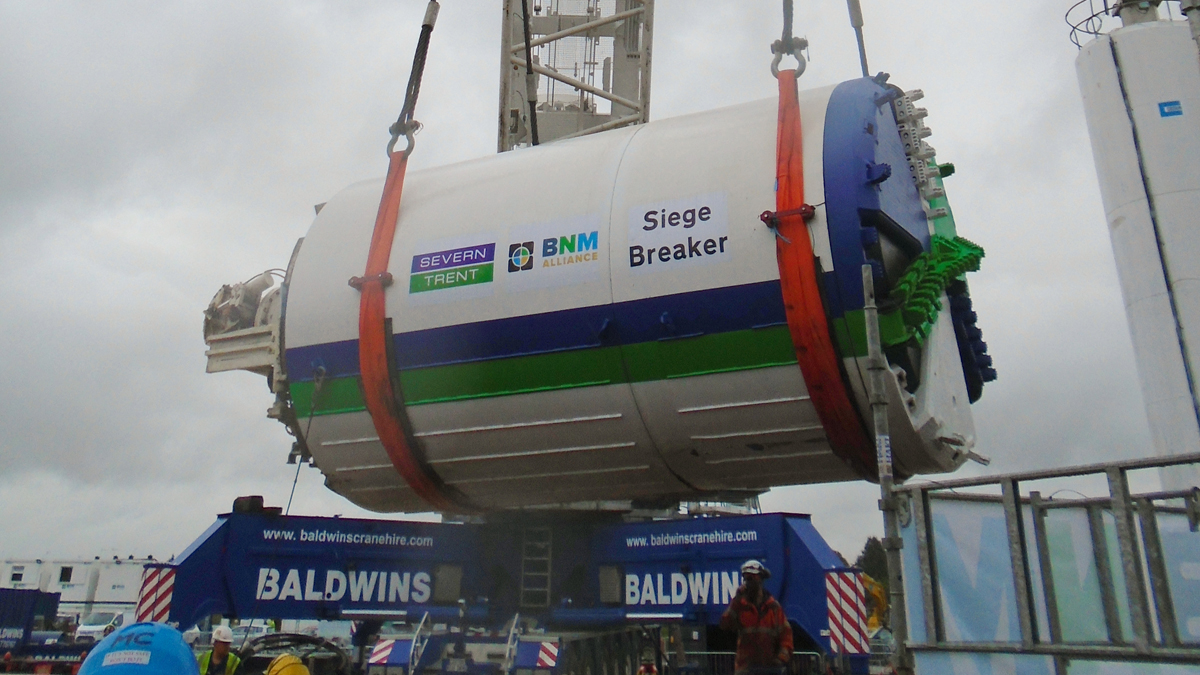
Crane lift of front section of Lovatt TBM before being lowered into the drive shaft – Courtesy of Severn Trent
As part of the approval gained from Network Rail to tunnel under the two railway lines, real time monitoring for twist and tilt, and three hourly observations to identify track movement, was set up. Prior to entering the zone of influence of the railway, an average volume of material excavated per ring section installed, was determined. Similarly an average quantity of grout usage was established, with these values forming a benchmark for monitoring, as the TBM passed through the zone of influence of the railway. This information was analysed to identify any trends which may indicate a problem, and was collated with the track monitoring results and information from the TBM driver into a report which was sent to Network Rail, BNMA and Severn Trent after every advance for a ring or pipe.
The smaller diameter pipe-jack tunnel was driven using, Iseki Unclemole slurry system micro tunnel boring machines owned by BNM Alliance. The hydraulic requirement was to provide a 1200mm internal diameter sewer, however some sections of the tunnel were increased to 1500mm internal diameter, to allow longer drive lengths to be achieved. This enabled shaft positions to be optimised, reducing disruption and programme risk.
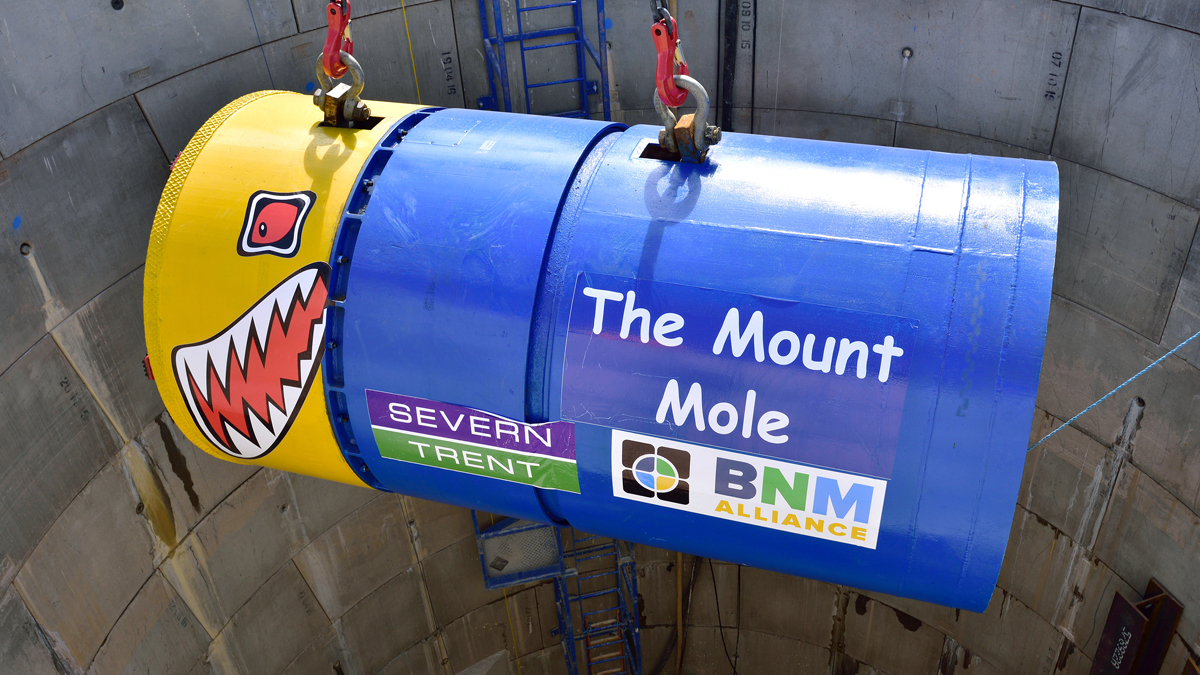
Iseki Unclemole TBM named in local school competition, being lowered into shaft – Courtesy of Severn Trent
The section of sewer from the end of the tunnel to London Road was originally specified as a 320m long 1050mm diameter open cut sewer, which required diversion of an existing gas main to enable its construction. When a higher than expected diversion cost for the gas main was received, the team extended the tunnel to London Road as this was both a more cost effective and less disruptive solution.
Shafts: A number of different shaft sinking techniques were employed, determined through the consideration of a number of factors. These included the particular ground conditions at each shaft location, the size of the structure required, secondary engineering requirements, e.g. to enable the launch or retrieval of a tunnel boring machine, the particular arrangement of any connections to the existing network and the area of available land.
The two deepest shafts, the drive shaft for the segmental tunnel and the TPS shaft were both formed as circular secant pile walls. Piles were extended 2m below the shaft formation level into the Mercian Mudstone to provide a cut off and minimise the risk of water ingress through gypsum bands within the mudstone. With diameters of 12m and 15.6m, these were the largest two shafts constructed. Whilst the diameter of the TPS was determined by its ultimate purpose, the diameter of the drive shaft was determined by the space needed to launch and service the segmental tunnel boring machine. Following installation of 1200mm diameter secant piles, a concrete capping beam was cast around the top of the secant piles prior to commencing excavation. Once down to formation, a concrete base was cast followed by headwalls with soft eyes formed for launch of the TBM. Once tunnel construction was complete a 4m diameter shaft was construct inside the secant pile shaft and the annulus backfilled with competent material.
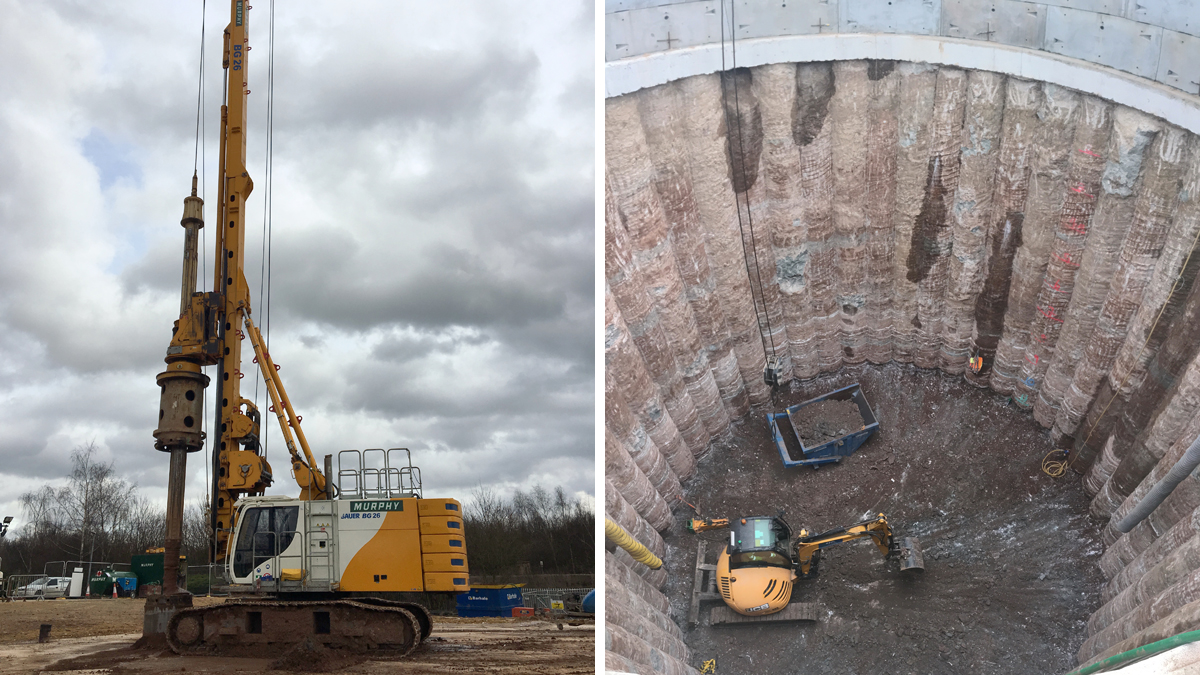
(left) Drilling of secant piles to form shaft and (right) excavation of secant pile shaft – Courtesy of Severn Trent
Nine of the shafts were constructed as segmental caissons, with diameters ranging from 4.0m to 7.5m. Groundwater was encountered in three of these shafts to the extent that they were progressed as flooded caissons. Once down to the required level, concrete plugs were formed beneath the water, which was then pumped out and a reinforced concrete base slab constructed. The extent of groundwater ingress in the remaining shafts was variable, but in each case could be controlled by sump pumping.
In two locations sheet pile shafts were formed, both of these were in highway locations where there was limited available space. Existing utility apparatus was either permanently diverted, or temporarily moved to enable the shafts to be constructed. As these shafts were close to residential properties, the ground was pre-augered to allow piles to be pushed to depth and the need to use vibratory hammers averted.
A one-way traffic system was set up around the town to enable the three drop shafts to be constructed on Castle Gate and North Gate one of which was right outside Newark’s 12th century castle. A 1200mm shaft was drilled from surface adjacent to the existing sewer, and a casing installed. Sheet piles were used to support the ground whilst an overflow chamber was constructed around the existing sewer. A stainless steel liner was inserted in the shaft casing, grouted in place, and a connection formed from inside the tunnel.
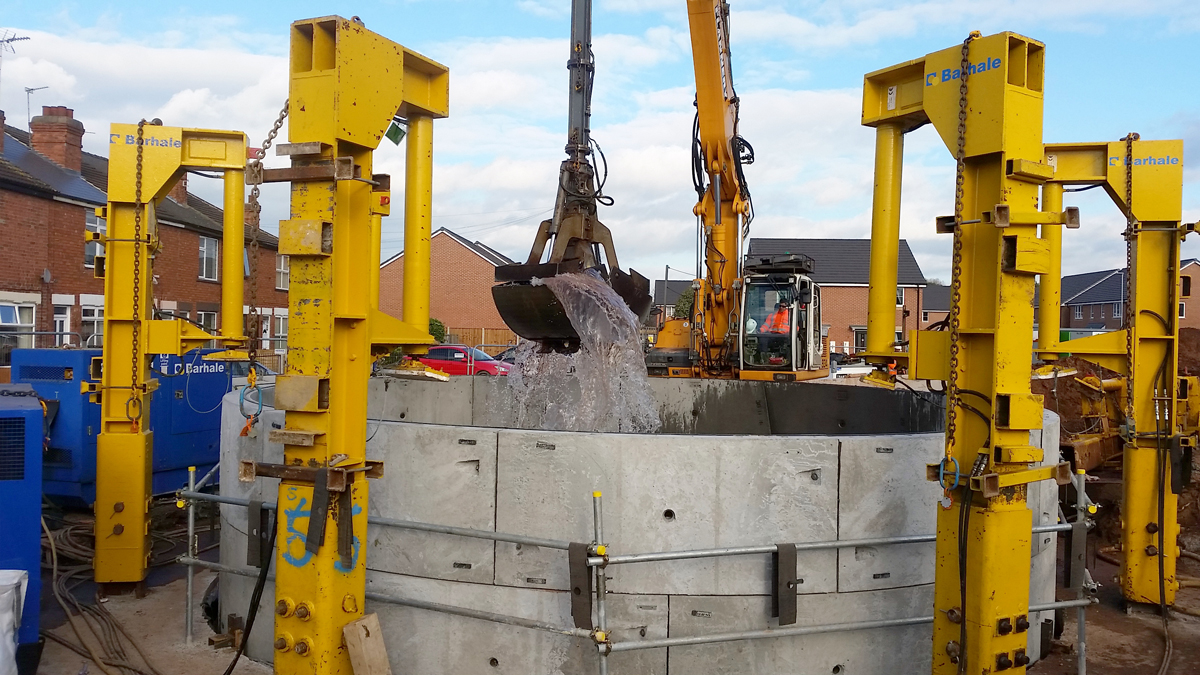
Excavation of flooded caisson shaft – Courtesy of Severn Trent
Open cut: A number of teams were employed on the open-cut sewer works in different locations across the town. These works were coordinated in close collaboration with Via East Midlands (Nottinghamshire County Council Highways services provider) with regular meetings held to discuss and agree the programme of works. The focus of the meetings was minimising impact to road users whilst maximising production, and expediting the programme to the benefit all parties. Through this collaboration, opportunities were identified for Via to upgrade traffic light systems at two locations whilst temporary traffic control was in place to facilitate the sewer upgrade works.
In total over 6.6km of new and replacement sewers with diameters ranging from 225mm to 1500mm were laid at depths of between 1.5m to 6m. Concrete, plastic and vitrified clay pipes were used, selected to suit the particular requirements of each location. The material excavated in the course of laying the new sewers was primarily sands and gravels which proved to be ideal for use as trench backfill material.
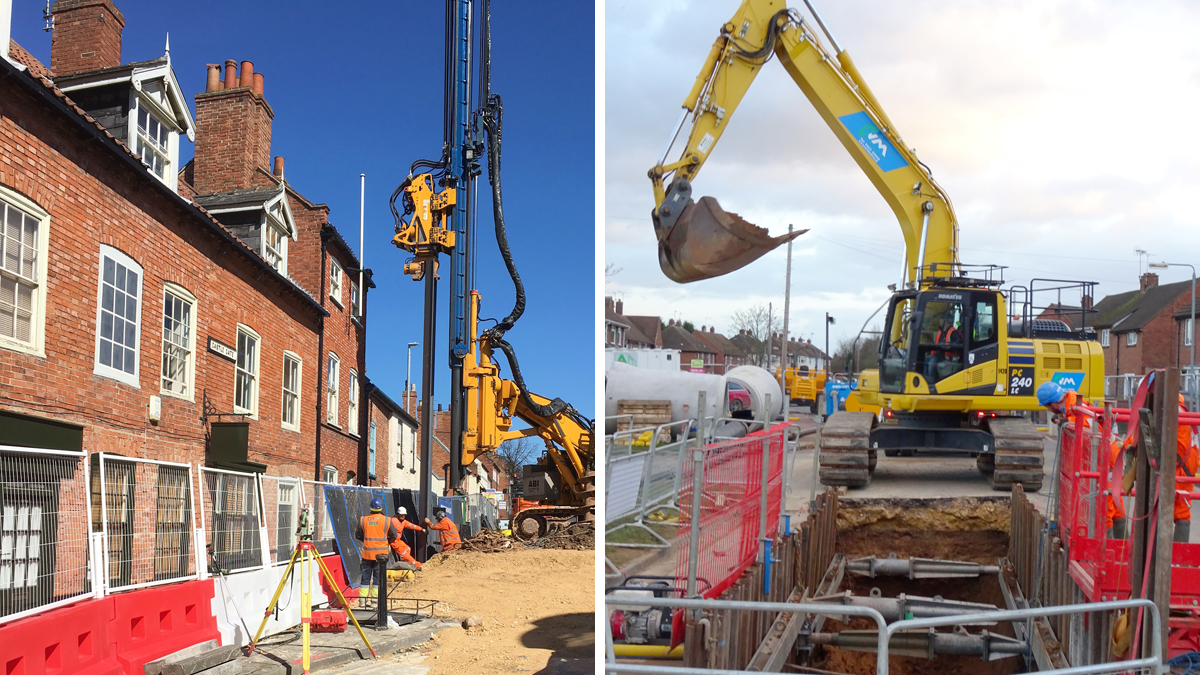
(left) Installation of sheet piles in close proximity to existing buildings and (right) sewer upsizing by open cut methodology in South Newark – Courtesy of Severn Trent
It was initially anticipated that ground dewatering would be required in a number of areas, and a dewatering system was installed for the construction of the first manhole. It was subsequently found that dewatering was not required, with the occasional groundwater incurred, managed with sump pumping.
Water: Design and construction
Over 11km of new inlet and outlet pipes of 400mm to 500mm diameter were laid, with connections to Beacon Heights Reservoir, and to the existing distribution network at key points to provide future system resilience. Cross connections were also installed either side of key infrastructure crossings.
At the East Coast Main Rail Line Crossing, two 7.5m diameter caisson shafts were constructed in fields to the north and south of the railway. Twin 600mm concrete sleeves were then micro tunnelled by pipe-jack approximately 4.3m below the railway. 500mm HPPE water mains were inserted through the 600mm concrete sleeves, with vertical pipework fixed to the shaft walls. The shafts were then backfilled with as-dug material and the fields reinstated.
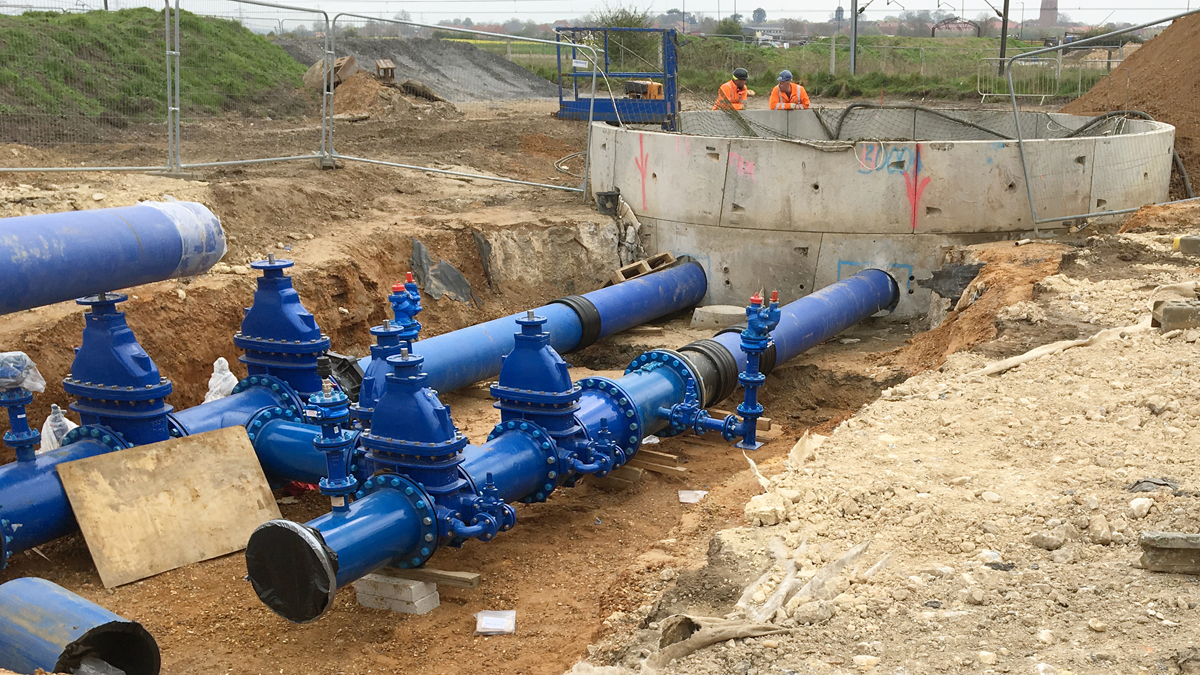
Cross connection of new water mains north of railway crossing – Courtesy of Severn Trent
At the northern crossing of the A1, Highways England gave permission for the inlet and outlet mains to be laid along Coddington Road beneath the bridge, where the A1 crosses overhead. Further south, the inlet and outlet mains cross beneath the A1 again and the B6326 through Balderton. Here the pipes were installed to a depth of 7m below the carriageways levels to meet Highways England settlement standards using horizontal directional drilling techniques.
As part of the detailed design process, the initial 32 locations selected for installation of isolating valves, were reviewed in liaison with the Severn Trent network operational teams. This identified that several of the locations proposed, would not fully offer the benefits intended. A revised schedule of potential locations, prioritised by the number of benefitting properties, was generated, and used to agree where valves were to be installed. Whilst there were a reduced number of locations, these were in more strategic positions, requiring larger valves, yet providing a comparable number of property benefits to the original plan.
The location of the proposed cross connection between the two strategic water mains was on a key through-route into and out of the town, close to a railway level crossing, with only notional information on diameter and position of the mains. A full road closure would be needed to undertake trial holes to determine the information required to enable the design to be completed, followed by further road closures to undertake the works. It was not clear however, whether the cross connection and arrangement of valves could actually be accommodated within the road at the required location. An alternative solution was developed to eliminate this risk by providing three new feeder pipes to ensure all areas could be supplied from either of the two strategic mains. Both the scope of work on the key through-route and the associated risks were reduced, with the work completed in a 24 hour off-peak road closure. The other two feeder pipes were in less traffic sensitive locations with no road closures required.
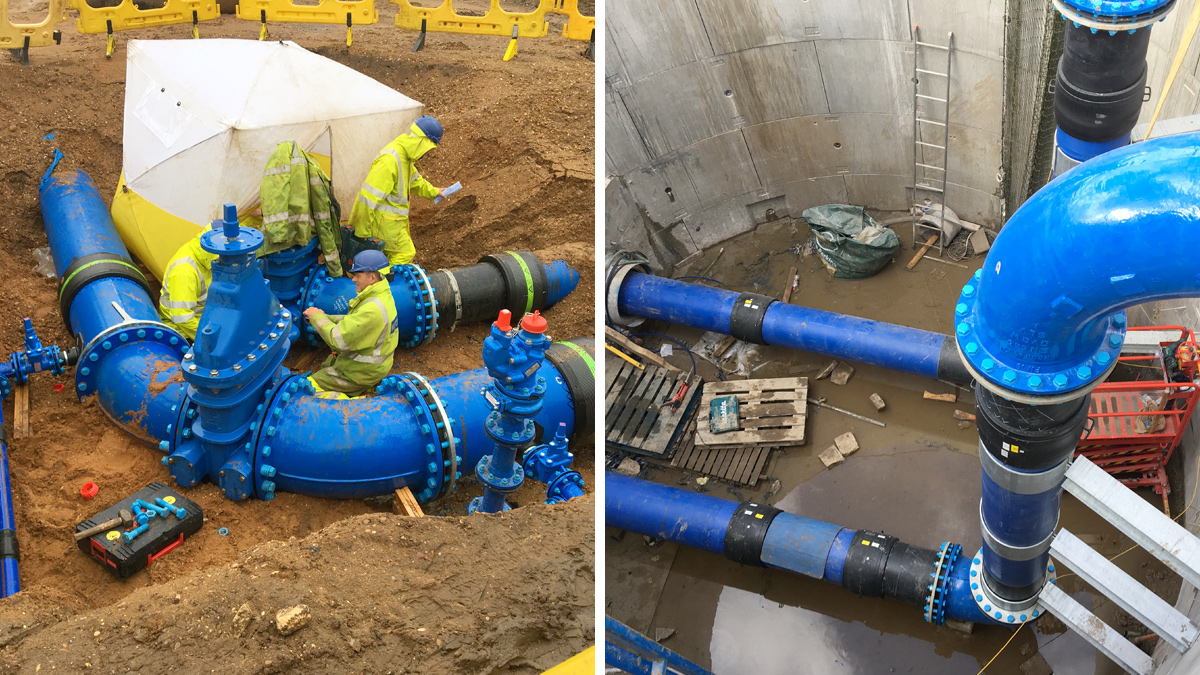
(left) Valve Installation and connection of the new mains to the existing water network and (right) pipework in caisson shaft at railway crossing, prior to backfilling – Courtesy of Severn Trent
A variety of techniques were used to replace life expired water mains, including pipe bursting, directional drilling and open-cut methods. Selection of the most appropriate technique was determined for each location. Factors influencing the decision included minimising the length of time that customers would be off supply, disruption caused by the works, and the location of other utility apparatus.
Through discussions with the Severn Trent network operational teams it became clear that there was an additional location where the network would benefit from the provision of pressure control. This was added into the scope of work, increasing the number of pressure management systems from four to five.
Stakeholder engagement
It was recognised at an early stage of the project that there was the potential for significant stakeholder impact in Newark given the need to work within the busy town centre on key highways, in archaeologically sensitive areas. Severn Trent set up a forum of interested parties from business groups, local councillors, and residents to share their plans and gain feedback on them to enable a solution to be developed which would minimise impact on the town. This helped develop understanding and trust, between all parties.
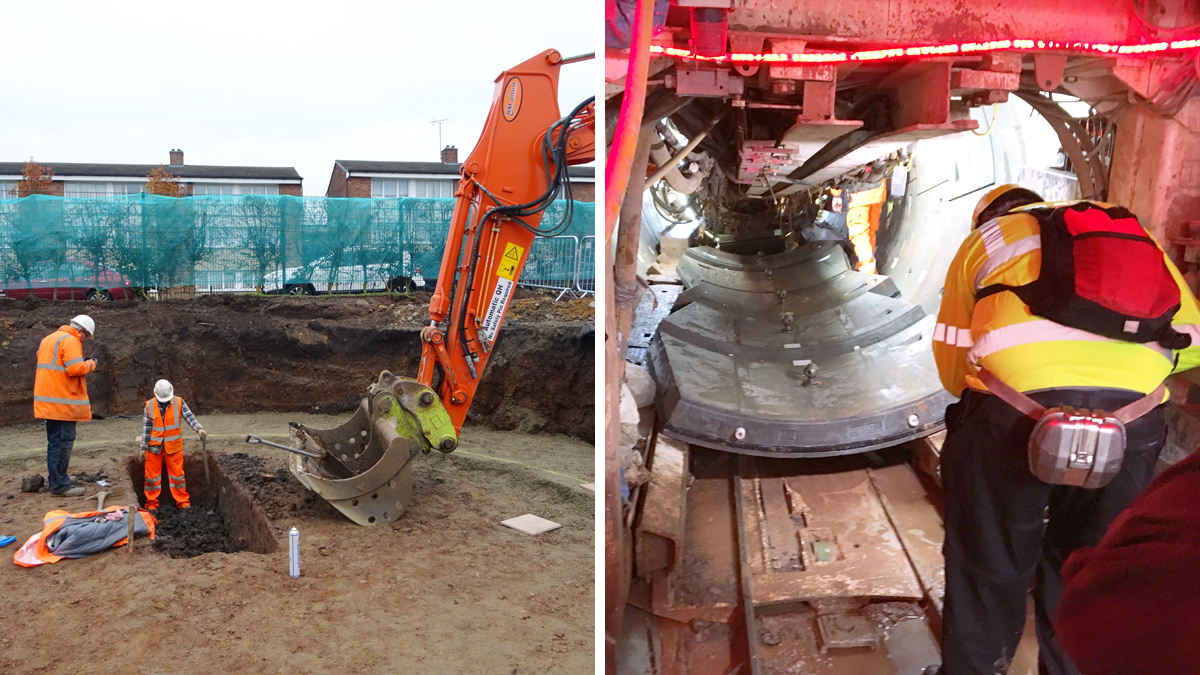
(left) Archaeologists discovered a defensive ditch at one of the shaft locations and (right) a BBC cameraman videoing the segment handler of the Lovatt TBM during one of their visits – Courtesy of Severn Trent
Prior to and during the construction phase an extensive stakeholder engagement plan was implemented, with numerous public exhibitions, presentations about the project given to interested parties and engagement with local schools. There was significant interest from the media with reporting of progress, and key events in newspapers, local radio stations and regional TV news programmes. Through the sharing of knowledge and information, the project left not only a legacy of pipelines and sewers, but a legacy of understanding within the community.











